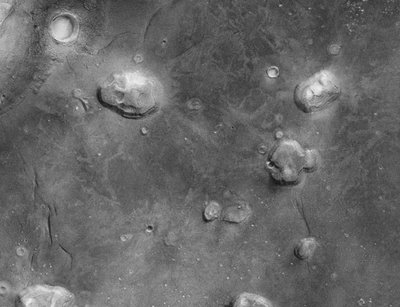Face on Mars Gets a Make-Over
After multiple attempts to image the Cydonia region from April 2004 until July 2006 were frustrated by altitude and atmospheric dust and haze, the High Resolution Stereo Camera (HRSC) on board Mars Express finally obtained, on 22 July, a series of images that show the famous 'face' on Mars in unprecedented detail.
 Original 'Face on Mars' image taken by NASA's Viking 1 orbiter, in grey scale, on 25 July 1976. Image shows a remnant massif located in the Cydonia region. On 31 July 1976, a NASA press release said the formation "resembles a human head." However, NASA scientists had already correctly interpreted the image as an optical illusion caused by the illumination angle of the Sun, the formation's surface morphology and the resulting shadows, giving the impression of eyes, nose and mouth.
Original 'Face on Mars' image taken by NASA's Viking 1 orbiter, in grey scale, on 25 July 1976. Image shows a remnant massif located in the Cydonia region. On 31 July 1976, a NASA press release said the formation "resembles a human head." However, NASA scientists had already correctly interpreted the image as an optical illusion caused by the illumination angle of the Sun, the formation's surface morphology and the resulting shadows, giving the impression of eyes, nose and mouth.
 The "Face" is show in gray scale similar to the Viking 1 photograph.
The "Face" is show in gray scale similar to the Viking 1 photograph. A perspective view showing the so-called 'Face on Mars' located in the Cydonia region. The image shows a remnant massif thought to have formed via landslides and an early form of debris apron formation. The massif is characterized by a western wall that has moved downslope as a coherent mass. The massif became famous as the 'Face on Mars' in a photo taken on 25 July 1976 by the American Viking 1 Orbiter. Image recorded during orbits 3253 and 1216 by the High Resolution Stereo Camera (HRSC) on board ESA's Mars Express. Image is based on data gathered over the Cydonia region, with a ground resolution of approximately 13.7 metres per pixel. Cydonia lies at approximately 40.75° North and 350.54° East.
A perspective view showing the so-called 'Face on Mars' located in the Cydonia region. The image shows a remnant massif thought to have formed via landslides and an early form of debris apron formation. The massif is characterized by a western wall that has moved downslope as a coherent mass. The massif became famous as the 'Face on Mars' in a photo taken on 25 July 1976 by the American Viking 1 Orbiter. Image recorded during orbits 3253 and 1216 by the High Resolution Stereo Camera (HRSC) on board ESA's Mars Express. Image is based on data gathered over the Cydonia region, with a ground resolution of approximately 13.7 metres per pixel. Cydonia lies at approximately 40.75° North and 350.54° East.
 Original 'Face on Mars' image taken by NASA's Viking 1 orbiter, in grey scale, on 25 July 1976. Image shows a remnant massif located in the Cydonia region. On 31 July 1976, a NASA press release said the formation "resembles a human head." However, NASA scientists had already correctly interpreted the image as an optical illusion caused by the illumination angle of the Sun, the formation's surface morphology and the resulting shadows, giving the impression of eyes, nose and mouth.
Original 'Face on Mars' image taken by NASA's Viking 1 orbiter, in grey scale, on 25 July 1976. Image shows a remnant massif located in the Cydonia region. On 31 July 1976, a NASA press release said the formation "resembles a human head." However, NASA scientists had already correctly interpreted the image as an optical illusion caused by the illumination angle of the Sun, the formation's surface morphology and the resulting shadows, giving the impression of eyes, nose and mouth. The "Face" is show in gray scale similar to the Viking 1 photograph.
The "Face" is show in gray scale similar to the Viking 1 photograph. A perspective view showing the so-called 'Face on Mars' located in the Cydonia region. The image shows a remnant massif thought to have formed via landslides and an early form of debris apron formation. The massif is characterized by a western wall that has moved downslope as a coherent mass. The massif became famous as the 'Face on Mars' in a photo taken on 25 July 1976 by the American Viking 1 Orbiter. Image recorded during orbits 3253 and 1216 by the High Resolution Stereo Camera (HRSC) on board ESA's Mars Express. Image is based on data gathered over the Cydonia region, with a ground resolution of approximately 13.7 metres per pixel. Cydonia lies at approximately 40.75° North and 350.54° East.
A perspective view showing the so-called 'Face on Mars' located in the Cydonia region. The image shows a remnant massif thought to have formed via landslides and an early form of debris apron formation. The massif is characterized by a western wall that has moved downslope as a coherent mass. The massif became famous as the 'Face on Mars' in a photo taken on 25 July 1976 by the American Viking 1 Orbiter. Image recorded during orbits 3253 and 1216 by the High Resolution Stereo Camera (HRSC) on board ESA's Mars Express. Image is based on data gathered over the Cydonia region, with a ground resolution of approximately 13.7 metres per pixel. Cydonia lies at approximately 40.75° North and 350.54° East.



0 Comments:
Post a Comment
<< Home